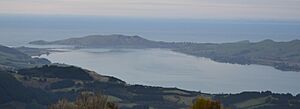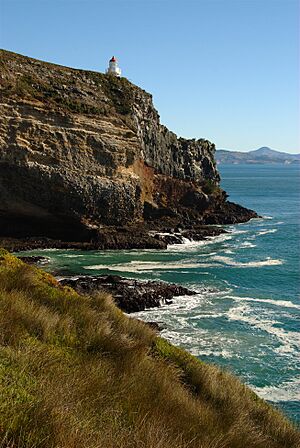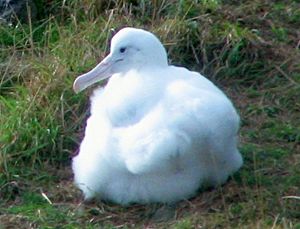Taiaroa Head facts for kids
Taiaroa Head is a special place at the end of the Otago Peninsula in New Zealand. It looks out over the entrance to the Otago Harbour, near the city of Dunedin. The closest small town is Otakou, about three kilometres south.
A lighthouse, built in 1864, stands proudly on the headland. Taiaroa Head is most famous for its colony of over 100 northern royal albatrosses. These huge birds made Taiaroa Head their home in 1919. It's the only place on an inhabited mainland where you can find such a colony! There is also a Royal Albatross Centre where visitors can learn about these amazing birds.
Contents
History of Taiaroa Head
This headland is named after Te Matenga Taiaroa. He was an important Māori leader, called a chief, from the Ngāi Tahu tribe in the 1800s.
Ancient Māori Settlement
A very important Māori village, called a pā, was located on Taiaroa Head. This pā was named Pukekura. It was built around the year 1650. Māori people continued to live there until the 1840s. A brave warrior named Tarewai, who lived in the 1700s, is connected to this place.
Early European Activities
A small beach there, now called Pilot's Beach, had a different name long ago. It was once known as 'Hobart Town Beach'. This was because the Weller brothers set up a whaling station there in 1836. They hired men from Hobart, Australia, to work with whales. Before that, it was called 'Measly Beach'. This was a place where Māori people went to bathe when they were sick with measles in 1835.
In the past, many whaling stations were built on the peninsula. Whales in this area were hunted a lot during that time.
Old Forts and Defences
You can still see the ruins of old forts and defences nearby. One cool part is a restored Armstrong disappearing gun. This type of gun could pop up to fire and then hide again. It was built in 1886. This happened because people were worried that New Zealand might be attacked by the Russians.
Wildlife at Taiaroa Head

A small beach called Pilots Beach is just inside the harbour entrance. Many kinds of sea animals can often be seen there. These include New Zealand fur seals and Hooker's sea lions.
Penguins and Other Sea Birds
Pilots Beach is home to the largest group of little or blue penguins on the Otago Peninsula. Close by are important places where the rare yellow-eyed penguin breeds.
Marine Mammals
You might also spot dusky dolphins and orcas (killer whales). Large whales that travel long distances, like southern rights and humpbacks, are also seen more often. Taiaroa Head is becoming one of the best spots along the Otago coast to watch these amazing creatures.
Protecting the Albatrosses
The part of Taiaroa Head where the northern royal albatrosses live is a special nature reserve. The New Zealand Department of Conservation manages it. Only people on guided tours can enter to protect the birds. Next to this area, the Otago Peninsula Trust runs a visitor centre. They also lead tours into the nature reserve. Pilots Beach is managed by Dunedin City for people to enjoy.
Royal Albatross Colony: Life Cycle and Care
The very first albatross egg at Taiaroa Head was found in 1919. But it wasn't until 1938 that a scientist named Dr. Lance Richdale saw the first baby albatross successfully fly away from the nest.
Since then, the number of royal albatrosses has grown. This is thanks to a lot of hard work by reserve rangers. They use special methods to help the birds, just like in other programs that protect endangered animals. The big difference here is that the adult birds and their chicks are not kept in cages. The adult albatrosses fly out each day to find food for their babies.
The rangers do many things to help. They control animals that might harm the albatrosses, like cats, ferrets, stoats, and weasels. In the early 1990s, a new type of blowfly caused problems. These flies laid eggs on the chicks, which could harm them while they were still hatching. Rangers also sometimes take eggs from young or new parents. These eggs are then hatched safely in special incubators.




